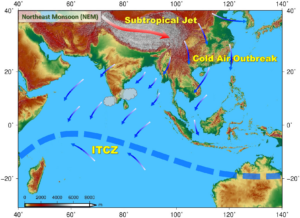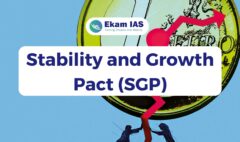RETREATING MONSOON IN INDIA
October 1, 2023 2023-10-02 15:23RETREATING MONSOON IN INDIA
WHY IN NEWS?
The Southwest Monsoon has withdrawn from parts of southwest Rajasthan on September 25, 2023, against its normal date of withdrawal from southwest Rajasthan of September 17
Usually, the southwest monsoon makes its onset over Kerala by June 1 and covers the entire country by July 8 while it starts retreating from northwest India around September 17 and the complete withdrawal by 15 October.
As per the weather department, this (2023) is the 13th consecutive delayed withdrawal of monsoon.
THE NORMAL RETRIEVAL OF MONSOON
The monsoon retreats from the western Rajasthan by the first week of September. It withdraws from Rajasthan, Gujarat, Western Ganga plain and the Central Highlands by the end of the month.
By the beginning of October, the low pressure covers northern parts of the Bay of Bengal and by early November, it moves over Karnataka and Tamil Nadu. By the middle of December, the centre of low pressure is completely removed from the Peninsula.
ANNOUNCEMENT OF MONSOON WITHDRAWAL
According to the IMD (Indian Meteorological Organisation) , the withdrawal of monsoon from extreme north-western parts of the country is announced based on three major synoptic features after September 1:
- No rainfall activity over the region for five days on the trot
- The establishment of anticyclone in the lower troposphere
- A considerable reduction in moisture content as inferred from satellite water vapour imageries and tephigrams (a chart depicting variations in atmospheric conditions relative to altitude)
The declaration of withdrawal from a specific region, may not be construed as total absence of rains for a longer period. Rains, if any, after sufficient gap need not be considered as revival of monsoon. Such a scenario is an inbuilt characteristic of retreating monsoon.
REASON FOR DELAYED RETRIEVAL
- Usually, by the end of September, the southwest monsoon becomes weak as the low pressure trough (ITCZ) of the Ganga plain starts moving southward in response to the southward march of the sun.
- The formation of successive low pressure areas over Bay of Bengal and their travel, deep in to parts of Madhya Pradesh, Gujarat on the outskirts of Rajasthan, has delayed the process of withdrawal 2023 monsoon season.
KEYPOINTS TO NOTE
Withdrawal of the monsoon from northwest India marks the beginning of its retreat from the Indian subcontinent.
August 2023 marked the driest month since 1901 and the hottest ever recorded in India, attributed to the strengthening of El Nino conditions.
However, September brought excess of rain due to multiple low-pressure systems and the positive phase of MJO (Madden Julian Oscillation) and IOD (Indian Ocean Dipole).
IMPACTS OF DELAYED WITHDRAWAL OF MONSOON
The extension of the monsoon into late September has had both positive and negative consequences.
Negative impacts:
- While the rains have helped reduce a precipitation deficit caused by an unusually dry August, they have also prolonged the agricultural calendar, creating challenges for farmers.
- One of the most critical impacts of a delayed monsoon retreat is on agricultural production, especially in northwest India. The monsoon’s timely arrival and retreat play a crucial role in the Rabi crop production, and any delay can disrupt the planting and harvesting schedules, affecting crops such as wheat, barley, and mustard.
- August 2023 was particularly harsh, ranking as the driest month in India since 1901 and the hottest ever recorded. This parched month resulted in moisture stress and raised concerns about declining crop yields.
- The acreage of pulses and oilseeds has witnessed a decline in comparison to the previous year, posing concerns for these important agricultural sectors.
The unexpected September rains have come as a boon, attributed to the positive Indian Ocean Dipole and favorable Madden-Julian Oscillation.
Positive impacts:
The delayed monsoon retreat has brought hope to key agricultural regions by replenishing soil moisture and reservoirs. This has benefited major crops like rice and soybeans, leading to an increase in the overall acreage of kharif crops. Despite the earlier monsoon deficit, this year’s extensive sowing areas for crops like paddy, sugarcane, and coarse cereals have surpassed the ‘normal’ acreage based on the average of the last five years.
The surplus rainfall in September has also raised hopes of easing food inflation in India. It may provide the Reserve Bank of India (RBI) with more room to maneuver in terms of monetary policy, potentially stimulating economic growth.
While the delayed monsoon retreat has posed challenges for agricultural scheduling and production, it has also brought relief to parts of India grappling with moisture stress. The extended rainy season in 2023 is a reminder of the climate’s unpredictability and its profound impact on the nation’s agriculture and economy.
WHAT HAPPENS AFTER WITHDRAWAL OF MONSOON?
Northeast Monsoon: When the retreating monsoon blows from the northeast across the Bay of Bengal, it picks up a significant amount of moisture, which is subsequently released after moving back onto the peninsula. Thus, from October to December the coast of Tamil Nadu state receives at least half of its roughly 40 inches (1,000 mm) of annual precipitation. That rainy extension of the generally dry retreating monsoon is called the northeast, or winter, monsoon.

October Heat: The retreating southwest monsoon season is marked by clear skies and rise in temperature. The land is still moist. Owing to the conditions of high temperature and humidity, the weather becomes rather oppressive. This is commonly known as the ‘October heat’. In the second half of October, the mercury begins to fall rapidly, particularly in northern India. The weather in the retreating monsoon is dry in north India but it is associated with rain in the eastern part of the Peninsula. Here, October and November are the rainiest months of the year.
Download the PDF Now
To UPSC-standard MCQs, join our Telegram Channel.
To get years of subjectwise-segregated newspaper articles, join our subjectwise Telegram Channels.
Join our 140k+ YouTube community to watch free classes on various UPSC related topics.
Follow us on Instagram for UPSC updates.
Click here to read more UPSC Current Affairs.
Ekam IAS is the oldest online IAS institute in Kerala. We’ve years of experience in mentoring and teaching students all over the nation, helping them achieve their UPSC-dream through the right guidance, strategy, and precise content. Join Ekam IAS and turn your UPSC-dream into reality.
To learn customizable preparation strategies, book an appointment with our UPSC-expert. Book Now.








